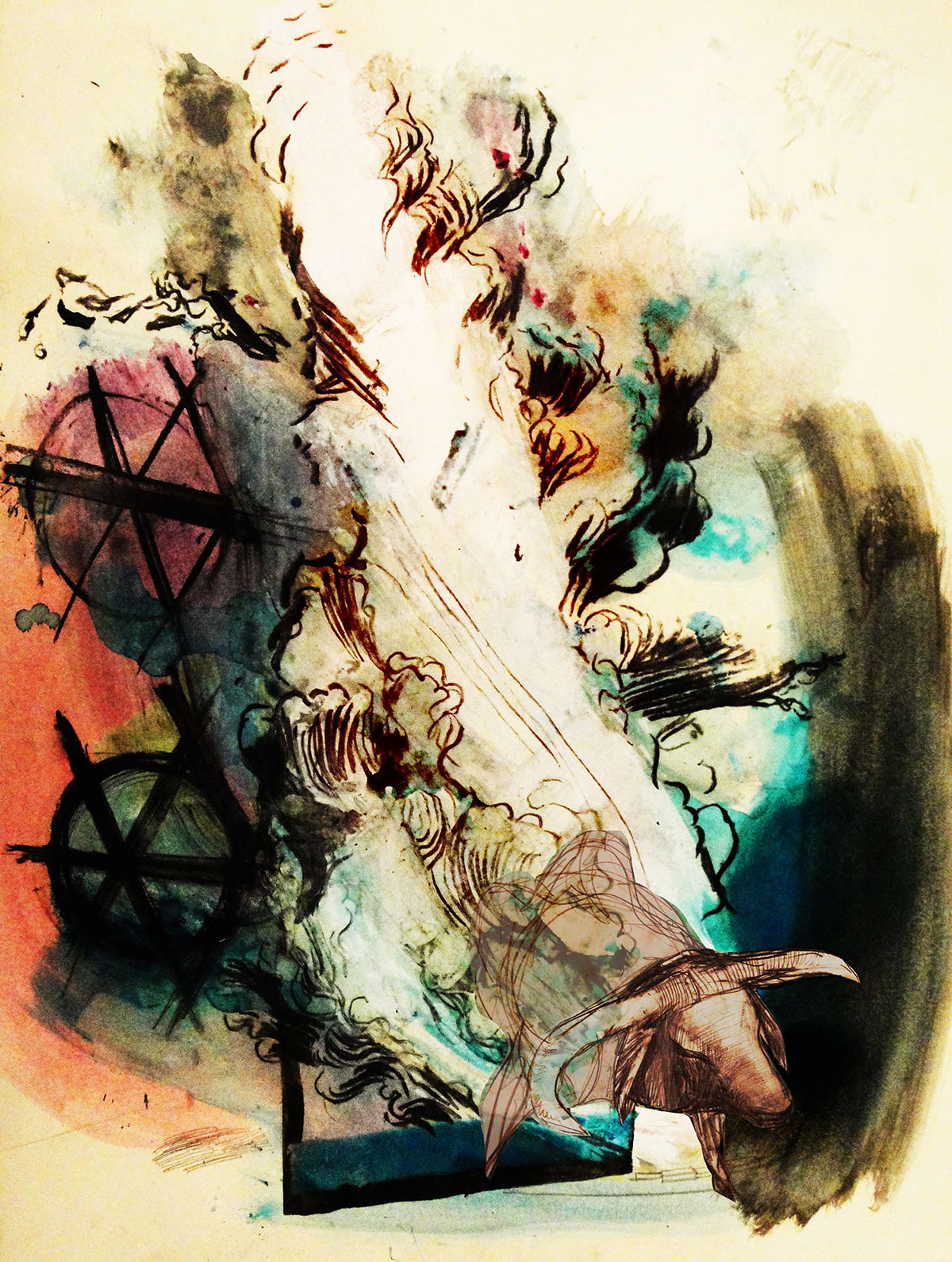
Mahishasura
The myth of Mahisha is a complex, multifaceted narrative with its origins in ancient India. I started working on these drawings because of a desire to investigate the evolution of some key decorative patterns in Indian sculpture and painting. I wasn't sure what form my investigation would take - something between a graphic novel and animation. I think I was drawn to the story of Mahisha because of the number of incarnations it has enjoyed over the centuries.
Strangely, after researching the story for many years, and eventually basing my MFA thesis project at UCLA on this story - I feel ever more confused and distanced from it - unsure if I really understand it at all. I think I initially had a kind of impulse to exoticize the subject matter, but not without a certain level of self-awareness. At this point, I've gotten over that and I think Durga is almost like Santa Claus in India, a pop icon who has been used for crude political and commercial purposes. On the other hand, like Santa Claus, the phenomenon of Durga does demonstrate a lot of very fascinating ideas that I think apply to many other stories - for instance how the way stories are told (orally versus written) changes the stories themselves - often for socio-political purposes.
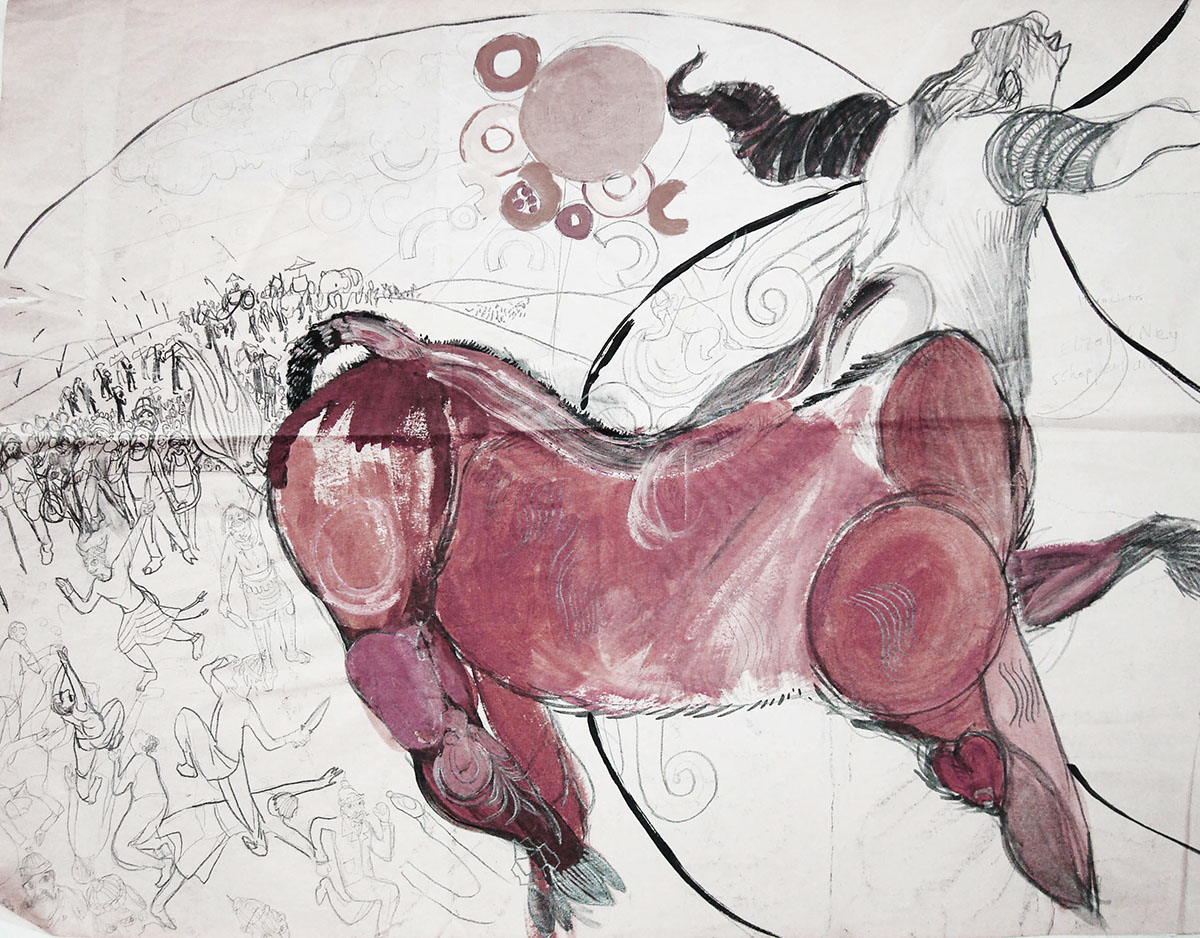
Mahisha wages war on the heavens
One of the easiest places to read about the story of Durga and Mahisha is in a series of Hindu religious texts called the Puranas. The Puranas are a collection of myths and stories written down by Hindu priests over the centuries. Durga and Mahisha's story is outlined in a book called the Markandeya Purana in a section called the "Devi Mahatmya" transcribed by a Brahmin priest named Vyasa some time around the 3rd-5th century AD. This version goes as follows: long ago a powerful Asura (rough translation "other"/demon) named Mahisha declares war on all the gods. He is an invincible Asura, and his army besieges the heavens for 100 years. Indra, the king of the gods, tries to fight back, but things are going badly. Eventually he asks for help from Siva, Visnu, and Brahma.

The gods ask for help
In response, all the gods pool their energy together to create Durga - a warrior to defend them all and a tiger for her to ride in to battle. Immediately after she is created, Durga roars and charges towards Mahisha's army. Mahisha sends his army to kill the goddess. Durga battles Mahisha's army for days. This is described in bloody detail in the poem, not unlike the description of war in the Odyssey or any other action-oriented epic with an oral tradition. There is an argument I will describe below for this battle having some basis in history. After finally getting to Mahisha himself, Durga discovers he can change shape. She attacks him many times, but each time he appears to have died he changes form. He transforms from a bull to a tiger, then a man, an elephant, and back into a bull. Durga eventually decapitates him mid-transformation, and he is gone for good. Durga successfully defends the heavens and assums her role as a symbol of power and protection. She notably mourns the death of Mahisha after killing him, acknowledging that he had only become so powerful from meditation and prayer.


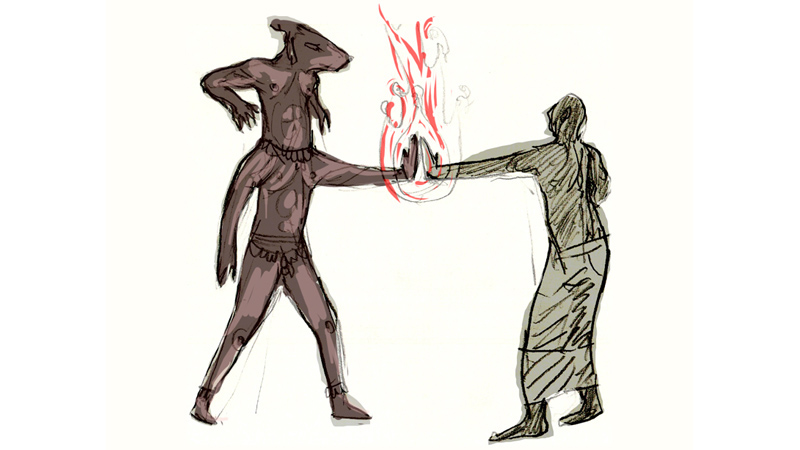
Mahisha is granted his powers in one version of the story from the Vamana Purana
Here are some sketches showing the creation of this invincible Asura Mahisha as I imagine him - emerging from gestural paisley patterns. My process was not linear. I used the evolution of Durga's iconography in sculpture, performance and painting as subject matter for the drawings. The relationship between decoration, craft, and religious/political power in India is fascinating. I am especially curious about the way Indian art has developed a metaphorical, poetic understanding of the human form.


An Asura names Mahishmati attacks a meditating priest named Sindudvipa.
But of course the origins of a demon like Mahisha are not simple. There are 6 different versions I was able to find, and I'm sure there are many more if you travel around and talk to people around India. Above and below you can see my drawings of a version of his origins described in the Varaha Purana: A priest named Sindudvipa is meditating in a temple he built when an Asura named Mahishmati comes by to take it from him. Mahishmati turns into a cow to drive him out, but Sindudvipa's father stops her from trampling him. He curses her to remain a cow until she gives birth. Sindudvipa much later is bathing in a river upstream from the cursed Mahishmati. Sindudvipa masturbates and as the semen floats downstream it impregnates Mahishmati. She gives birth to Mahisha, the invincible Asura who terrorizes heaven.


Mahishmati is cursed for her actions to stay in the form of a cow, and later becomes pregnant after unintentionally drinking Sindudvipa's semen.
In this version and those like it you might read themes related to the tensions between the cohabiting cultures of the Indus Valley- the "Aryans" and the "Asura," according to Upendra Nath Dahl, the author of a book called Mahishasura in Art and Thought. Dahl writes that the Asura described in the Puranas could have been indigenous Assyrians who had peacefully settled the Indus Valley before the northerners arrived. Mahishasura could have been a historical figure who is found in some early primary documents dating back thousands of years, a descendant of these Assyrian settlers who were seen as the "other" in the mainstream Brahminical Hindu narrative.

Another version shown below from the Devi Bhagavata in the Vamana Purana illustrates these themes as well. This story goes as follows, according to Dahl's translation: a king named Danu has two impotent sons - Rambha and Karamba. When they reach adulthood they each go to perform extreme acts of religious self-sacrifice to try to gain their fertility and continue the family line. Karambha submerges his body up to the neck in a river and stands without food. Rambha goes into the forest and just waits under a Peepal tree. Karambha is eaten by a crocodile - it was a volatile, capricious Indra who was acting out of malice.


Rambha and Karamba praying for fertility. Karamba is eaten alive so Rambha tries to commit suicide.
When Rambha hears about this he decides to kill himself out of sorrow and despair. Another elemental god Agni (the god of fire) comes to his rescue, deciding to grant his wish of fertility. He can have a child with any animal. Rambha walks off in a daze, and sets his eyes on a female water buffalo named Syama. They have sex and she gets pregnant. Now instead of stopping here, the narrative gets more complex, perhaps supporting the idea that this story is really an exploration of ethnic tensions.



Syama seeks protection from Rambha.
Before giving birth Syama is harassed by a wandering bull. Syama seeks protection from Rambha, the bull and Rambha get in a fight, and both of them are killed. An Asura called Raktivija is born from the dead body of Rambha. Syama sees that Rambha is dead and builds a funeral pyre; here's another clue that this is a metaphor for ethnic conflict. While Syama is dying in the flames of the pyre she gives birth to Mahisha, the invincible Asura.



Syama kills herself and gives birth to Mahisha.
Below is a drawing (charcoal and gouache) of the battle as I imagine it. In the Devi Mahatmya it is described as a war lasting 100 years, in which Mahisha leads all the Asura against the gods, who are lead by Indra. I was trying to capture something about the Bhakti movement of the 50s in India, which combines romantic renderings of deities with painterly, expressionistic backgrounds.

Mahisha the Buffalo Demon terrorizes the heavens
The sequence of images below shows something I find especially interesting about the myth. In Pargiter's translation of the Devi Mahatmya, the creation of the goddess Durga is described in the following way:
"The devas saw there a concentration of light like a mountain blazing, pervading everything with its flames. Then that unique light, produced from the bodies of all the devas, pervading the three worlds with its luster, combined into one and became a female form."
"By that which was Siva's light, her face came into being; by Yama's light her hair, by Vishnu's light her arms; and by Candra's (the Moon) light her two breasts. By Indra's light her waist, by Varuna's light her shanks and thighs and by earth's light her hips."
"By Brahma's light her feet came into being; by Surya's light her toes, by Vasus light her fingers, by Kubera's light her nose; by Prajapati's light her teeth came into being and similarly by Agni's light her three eyes were formed. The light of the two sandhyas became her eye-brows, the light of Vayu her ears; the manifestation of the lights of other devas too contributed to the being of the auspicious Devi."
"The devas saw there a concentration of light like a mountain blazing, pervading everything with its flames. Then that unique light, produced from the bodies of all the devas, pervading the three worlds with its luster, combined into one and became a female form."
"By that which was Siva's light, her face came into being; by Yama's light her hair, by Vishnu's light her arms; and by Candra's (the Moon) light her two breasts. By Indra's light her waist, by Varuna's light her shanks and thighs and by earth's light her hips."
"By Brahma's light her feet came into being; by Surya's light her toes, by Vasus light her fingers, by Kubera's light her nose; by Prajapati's light her teeth came into being and similarly by Agni's light her three eyes were formed. The light of the two sandhyas became her eye-brows, the light of Vayu her ears; the manifestation of the lights of other devas too contributed to the being of the auspicious Devi."



Siva, Visnu, Brahma, and the directional gods create Durga.
I find this interesting because it hints at the multiple histories contained within the form of this goddess figure. In my thesis project I explore the origin of the Durga myth a little more, but for now I will mention that there are dozens of different goddesses found across India with similar stories to Durga. Her manifestation in the Markendeya Purana in my opinion is an attempt to bind all of these entities into one unified narrative, to concentrate this spiritual/political power in one idea. And perhaps this effort discourages a very literal or specific representation of the goddess in the art of the time. Or at least artists employed to sculpt the figure of Durga on the surface of temples reached toward a style that would speak to all audiences, each with their own local version of the Devi.


Durga roars and charges towards Mahisha's armies.
Durga went to fight Mahisha, and encountered waves of his forces. The poem goes into bloody detail about this battle for many pages. It describes Durga cleaving her enemies in half with swords and decapitating them with her weapons. Dead Asura continue fighting like headless chickens, and others keep playing their instruments like a scene out of "From Dusk Till Dawn." As I mentioned above the author Upendra Nath Dahl thinks this might be based on some sort of historical conflict between Indus valley settlers and Aryan new-comers (possibly invaders). So in some ways this part of the story is not unlike the Odyssey or the Iliad - it's a glamorization of war. I guess at least some of this is also simply for entertainment, so I thought it would be fun to play around with different ways of modernizing or poking fun at the violence. Though now dated, when I was drawing this 8-9 years ago I thought it would be funny to include xbox controllers, playstation controllers, jack-in-the-box harpies, and more :) You may notice I also tattooed Mahisha with some somewhat dated symbols from that era (early 2000s) as well lol.
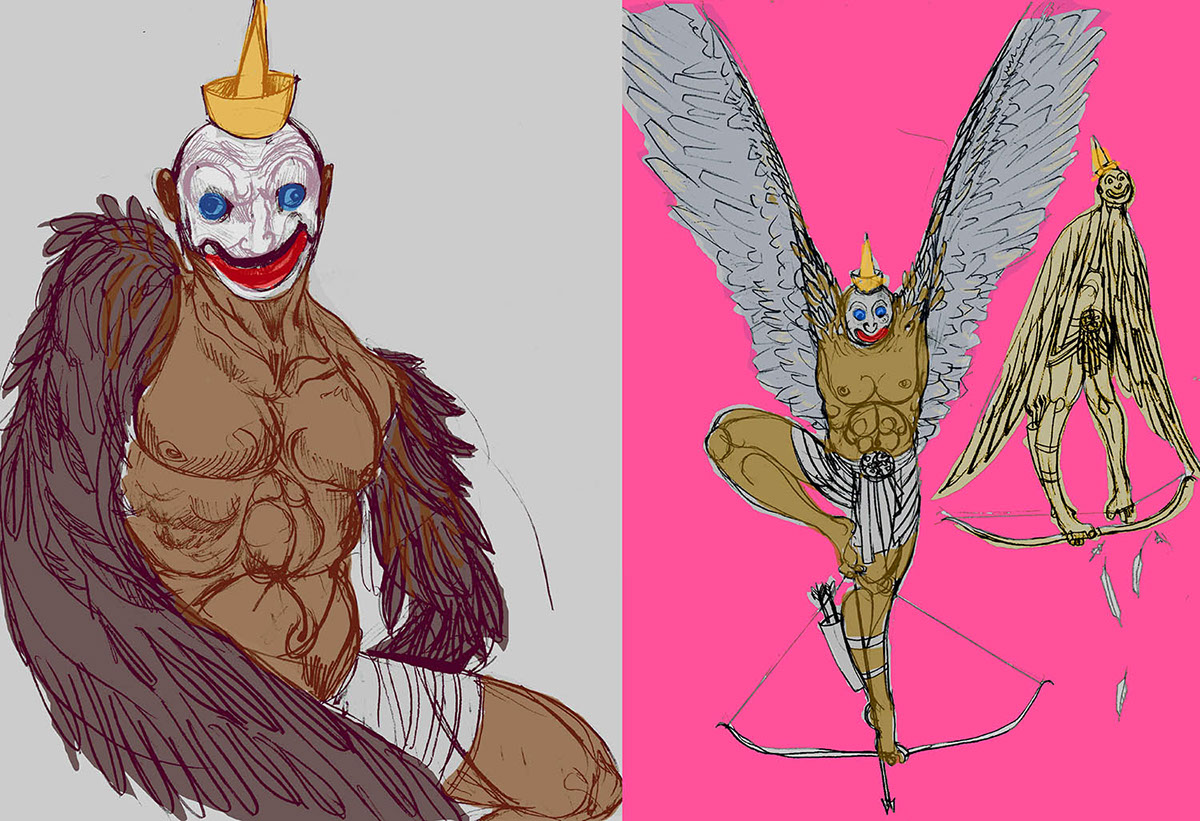


Durga fights Mahisha's army.
The last part of the story is a battle between Mahisha and Durga. This might be the most interesting part of the story from an analytical or cultural perspective. The narrative is that Mahisha kills most of Durga's army while in the form of a giant bull.
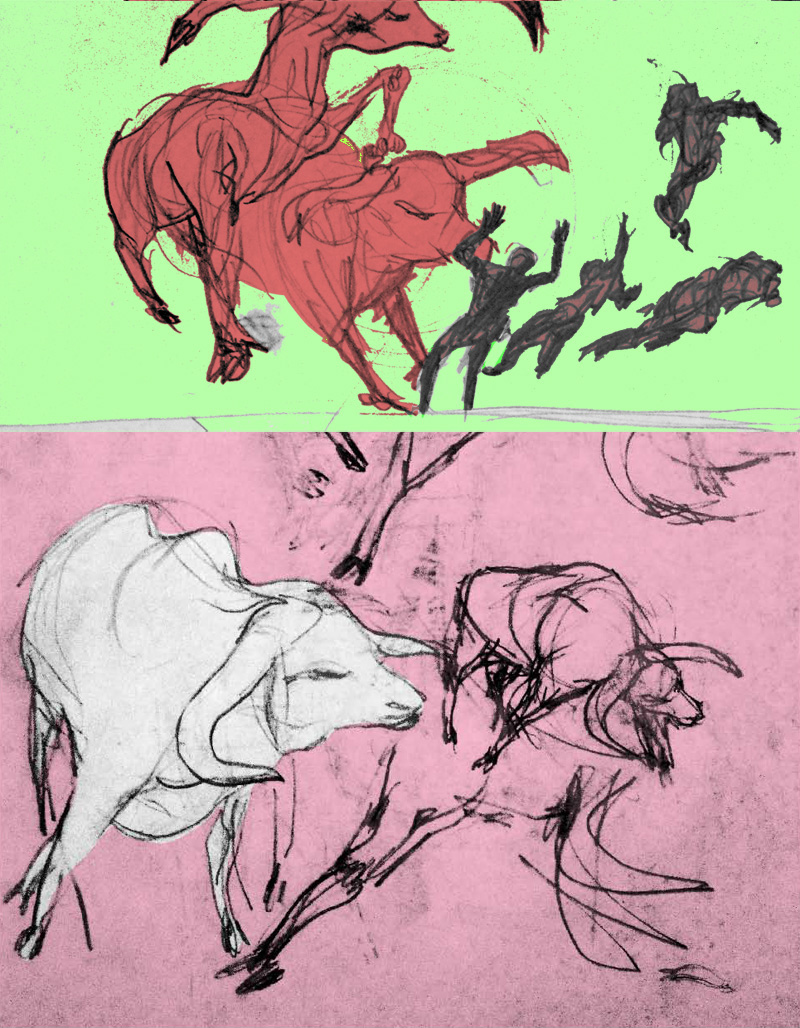
Mahisha transforms into a bull.
Enraged, she lassos him with a giant noose. He then takes the form of a tiger to escape, but she catches up to him and cuts off his head.


Mahisha changes shape four times while fighting Durga.
As she is doing this, Mahisha transforms again into a man with a scimitar and a shield. Durga shoots him with an arrow so strong it goes right through his sword and shield. Mahisha changes shape into a large elephant and grabs her lion this time, but Durga cuts off his trunk.

Durga finally kills Mahisha.
Finally Mahisha changes back into a giant bull, and hurls an entire mountain at her with his massive horns. Durga shatters the mountain with her arrows, and then declares she's going to kill him once and for all. She jumps up and stabs him with her spear (from Siva I think), finally extinguishing the near-invincible Asura.
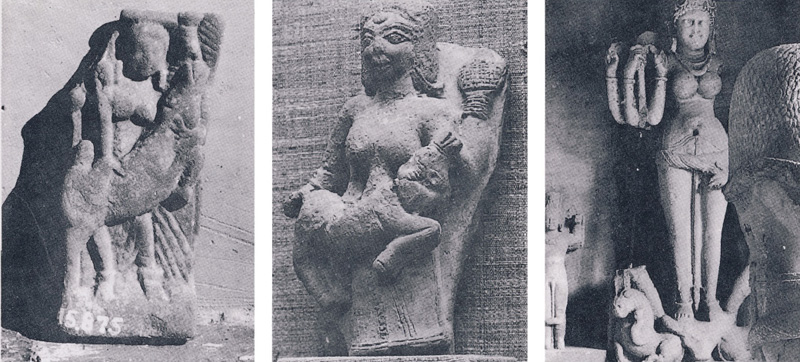
Sculptures of Mahishasura Mardini across India ranging from 1st - 5th Century CE. Images were originally published in The Divine and Demonaic: Mahisha's Heroic Struggle With Durga, by Carmel Berkson. Delhi: Oxford University Press, 1995. plates #16, 17, and 20.

On the left is a relief of Mahisha fighting Durga from the 7th century CE at Mamallapuram in Tamil Nadu, and on the right a sculpture of Mahisha at Chamundi Hill in Mysore, Karnataka. The image on the left was originally published in The Art of Ancient India by Susan and John C. Huntington, New York, Weatherhill 1985. page 302. The image on the right was originally published in The Divine and Demonaic: Mahisha's Heroic Struggle With Durga, by Carmel Berkson. Delhi: Oxford University Press, 1995. plate #9.
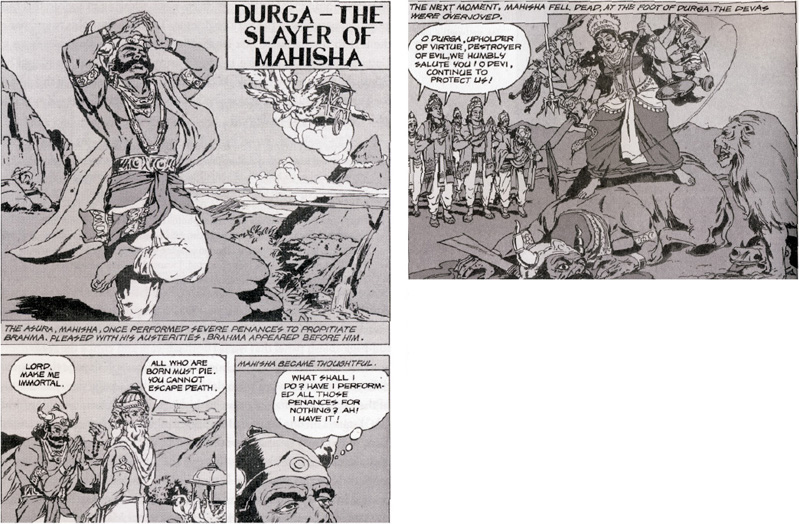
"Durga The Slayer of Mahisha" from Tales of Durga, Amar Chitra Katha Comics, no. 176. India Book House Pvt. Ltd. 1978. page 1
The above images show how the portrayal of this battle changes over the years and across media. In the earliest depictions of this story - for instance the second image in the slideshow above from the 4th centure C.E., Mahisha is perhaps merely a stand-in for an animal sacrifice. He is shown small and almost defenseless. Later depictions begin to explore Mahisha as a entity with agency and power - for instance the first image from the 7th Century C.E. where you can see a large, minotaur-like Mahisha with a club in hand ready to strike at a relatively diminutive Durga. I already mentioned the possible relationship between a historical figure and the mythical being that may have become more prominent in later versions of the story. The American sculptor and author Carmel Berkson has a more psychoanalytical interpretation of this shift - she believes the Durga myth started to assume a kind of familial metaphor or symbolism, where Mahisha could be considered an errant son coming of age, and Durga could be a fiery mother figure. She describes this sculptural relief as, "an expression of the male fighting valiantly for his own liberation from the destructive maternal orbit." I'm not sure I agree with this line of thought, but I suppose you could argue that there might be some kind of Oedipal tension between the two characters, as suggested in the version of the story told in the Vamana Purana, where Mahisha at some point expresses lust for Durga, and even asks her to marry him. Of course there are some places where Mahisha is depicted as a hero, so this Freudian interpretation only works for the "mainstream" narrative.

In some versions of the story Mahisha is smitten by Durga and asks for her hand in marriage.
I'm obviously still fascinated by the scope and depth of this story. The way it continues to evolve with one arm in the past and another guided by the hands of new generations of storytellers is really captivating. I feel like the story of Durga is a vast thicket of ideas accumulated over millenia of spiritual practice and bloody history that persists today because of fundamental human impulses we can't suppress. So Mahisha is reborn in the fall for every Navratri festival; maybe he really is invincible after all :)

